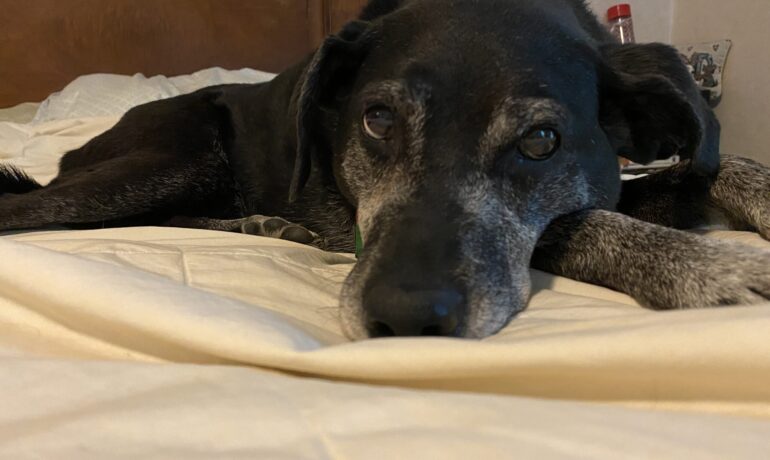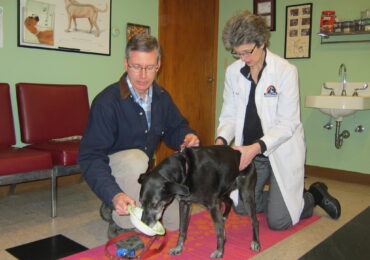 What is going on with my old dog?
What is going on with my old dog?
As a primary care veterinarian, I have often had the bittersweet pleasure of caring for a furry family member from puppyhood to the end of life. At times, I would see a sweet, friendly dog show behavior changes that seemed out of place and confusing to the pet parent. As my expertise in behavior grew, so did my knowledge of the effects of aging on the body and the brain. I could help my clients understand how the neurological changes in their aging dog would reflect behavior changes. Over my 30 plus year career, I see dogs advance in age and have found three categories of behavior changes stemming from three areas of aging changes. Many older dogs show increased aggression, anxiety, or compulsive behaviors. These behaviors are aggravated by body inflammation, sensory changes, and cognitive decline.
Anxiety – Aggression – Compulsion
It is important to use the correct definitions of aggression, anxiety, and compulsion in dogs to communicate accurately with veterinarians, behaviorists and trainers. It is much more clear to me as your veterinarian when you say ” My dog is growling, snarling and snapped at my grandchild” than to say ” My dog grumbles a little and makes a funny face around my grandchild”. I now know how your dog is escalating up the ladder of aggression and what situations at home I need to help create a plan for safe interactions.
Aggression is defined as agnostic body language directed towards a perceived threat. Use the Canine Ladder of Aggression by Kendal Shepherd DVM as a guide to accurately describe the body language of aggression. Canine ladder of aggression handout From the chart, you can see the switch from anxiety to aggression occurring at stare – stiffening up. This is the first level of aggression and increases to the bite. The stare is a warning, as is the growl and snap. Get your dog away from the stimulus. This is the first order of decreasing aggression. Even if your dog tolerated noises, or touch in the past if they are growling now they are escalating up to a bite. It just has not happened yet. It is very important to use the words on the scale when you describe your dog’s behavior. Please do not discount staring – growling or snarling as just a bit of a problem. I have had so many cases where people would say “He growls but it is not a problem”. Yes, it is – your dog is not bad. He is likely painful, cannot sense what is coming, or has cognitive problems.
Anxiety is defined as “apprehensive uneasiness over an impending or anticipated ill.”(2) When your dog walks with the tail down, ears down, and walks away from a stimulus that dog is saying ” Something bad is going to happen and I am trying to get away”. The body language of Canine Fear by Sophia Yin DVM is a great handout to use to recognize and identify anxiety. The body language of pain is very similar to anxiety. Both may be present. Canine Body Language of Fear handout.It may seem really odd that an older dog who tolerated noisy kids is now pacing around the house, panting, drooling, or whining. Pain, vision and hearing problems, and cognitive decline all increase anxiety. Tell your veterinarian – anxiety raises the heart rate, stress hormones and worsens health problems.
Compulsion is defined as ” repetitive, unwanted, and functionally impairing overt or covert behavior without adaptive function ” (3) Examples are dogs who lick their skin until an Acral Lick Granuloma forms. While the actions may not cause deep harm, the repetitive nature of the behavior may interfere with the ability to play, explore the home, go on a walk or there may be a risk of self-injury. Determining if the lick granuloma is a compulsive behavior, response to a painful joint, or skin inflammation will be determined by your veterinarian. Often a mix of medications to address all of these factors is needed to decrease compulsive problems in the aging dog.
Pain – Sensory input – cognition
Pain is ” an unpleasant feeling conveyed to the brain by sensory neurons “(1). Inflammation changes the speed and ability of nerves to transmit the sensation of touch, heat, and pressure from any stimulus. Serotonin is an important chemical that decreases the sensation and perception of pain. Inflammation alters serotonin levels and as a result, increased pain is often perceived. Growling is often a tactic to guard the space around a painful dog to decrease touch from others. The painful dog cannot get up and leave easily. Growling, snarling, and snapping is an effective tactic to keep others away when pain is present. It was very common for me to find an older pet was “grouchy” at the grandkids. When the source of the pain was treated, the behavior improved. When people mentioned how “grumpy” their older dog was, my first thought was to check for body inflammation and get that under control! In one case, a shepherd dog who was now growling at the toddlers had a bad tooth. I removed the bad tooth, prescribed pain relief, and a clear child safety plan. When I asked how the dog was around the children 3 days later at the dental recheck, the owner said the dog stopped all the growling and was accepting petting and child activity. This is an example of how pain can create aggression.
Sensory input is the transmission of information from touch, sound, movement. taste and odor t the brain for interpreting the environment. Vision and hearing the two senses that decline in many dogs over the age of 10. Dogs accommodate their world as they become blind and deaf. The progression of sensory loss will depend on the breed and health of the dog. many toy dogs age at a slower rate than large breed dogs. Diabetes and high blood pressure are health factors that will decrease vision no matter the breed. Most older dogs startle easily because they cannot see or hear noises until they are upon them. Startle aggression is a common problem in our older dogs. It would break my heart to hear how a sweet old poodle bit the grandchild when hugged as the dog slept. As a younger dog, this was tolerated but now in a dark silent world, it is a sudden surprise to the dog. clapping your hands, shuffling your feet on the floor, and speaking loudly to announce yourself before your pet, or pick up your older dog can avoid startle aggression problems.
Cognition – Cognition means the ability to remember the steps of a learned skill. In short, your dog knows to go to the door, bark or bang the bell to be allowed outside to go to the bathroom. Now, your old dog may go to the door but stop there. They cannot remember the step of barking or banging the bells and as a result house-soiling. They may not play as much or seem to care to greet you. Cognitive Dysfunction Syndrome was established as a diagnostic category in the 1990s. Diagnosing this disorder is a process of elimination of other common aging problems (4) A dog who is painful upon rising or walking to greet you will look like interactive changes. Housesoiling may be due to kidney problems creating dilute urine that is difficult to hold. Sleep patterns may be off due to night discomfort from pain. There are numerous supplements, medications, and alternative therapies that help reduce brain aging that adds to cognitive decline. Often, treatment is a customized plan based on balancing the physical effects of aging with the mental decline to increase the quality of life. One of the blessings in our pets is that the personality changes are not as evident in dogs as they are in humans with cognitive decline. Many dogs show anxiety as a symptom which is often managed with supplements and diet. The house soiling and sleep cycles are often the quality of life issues for the pet parent that bring out end-of-life discussions.
How to get the best behavior from your old dog
Here are my tips for getting the best behavior from your older dog.
- Have a full check-up, bring in urine and stool and say yes to senior bloodwork or x rays as suggested by your veterinarian to know what may be behind any inflammation or pain. If you have to space out these tests as your budget allows please tell your veterinarian!!! There are payment options like Care Credit to help with budgeting. If you only refuse care, problems will get worse, and then it will cost more to help you out. We can prioritize the tests, and help determine the most affordable ways to help your pet.
- Take your older dog on a walk based on their ability. Three 5 minute walks a day is as better than one 15 minute walk. These short walks wake up their brains, get the blood flowing through the body to decrease pain and inflammation, and gives them an opportunity to eliminate outside and avoid house-soiling problems.
- Get rid of the food bowl and use food puzzles. Flipping around a kong gives them an opportunity to use their nose, and enhances taste and appetite. It also strengthens cognition helping to slow down the decline.

- Set up areas for your older dog to get away from noise and activity and be happy. Set up baby gates with a soft bed to avoid those toddler hands or people tripping over your dog who cannot get up and out of the way.
- Stay on the medications., supplements, and the diet recommended by your veterinarian. Keeping the inflammation away is best for behavior. It would drive me crazy when clients would stop medication because the dog was “better” then come back because the dog was grouchy or painful again. The up and down of pain – , medication – quit – pain increases brain and body aging. If you are concerned about long-term medication effects please discuss this with your veterinarian. Medications can be adjusted, decreased, and alternative therapies are available for your dog.
Lastly, older dogs can be trained and counter conditioned for anxiety, aggression, and compulsive problems. If you are experiencing behavior difficulties with your dog, please contact me and I can work with you and your veterinarian to help your dog. Often there is a blended medical – aging – behavior problem that is best addressed as a collaborative approach from a veterinarian with behavior expertise and your primary veterinarian. We are here to help you and your dog!
I will be hosting a senior dog workshop July 7 – register here https://www.drsallyjfoote.com/event/senior-dog-behavior-workshop-july-7-53-0-7-pm/
Thanks
Sally J Foote DVM, CABC-IAABC,LSHC-S
References:
- Kumar,k. Elevarsi,P Definition of pain and classification of pain discorders. http://jcri.net/eJournals/ShowText.aspx?ID=112&Type=FREE&TYP=TOP&IN=_eJournals/images/JPLOGO.gif&IID=12&Value=1&isPDF=YES accessed 6/28/21
- https://www.merriam-webster.com/dictionary/anxiety
- Alonzo,p. Lopez-Sola,C. et al Animal Models of OCD – Utility and Limitations https://www.ncbi.nlm.nih.gov/pmc/articles/PMC4531004/ accessed 6/28/21
- Ozawa,M. Inoue,M. et al Physical signs of Canine Cognitive Dysfunction https://www.ncbi.nlm.nih.gov/pmc/articles/PMC6943310/ accessed 6/28/21


